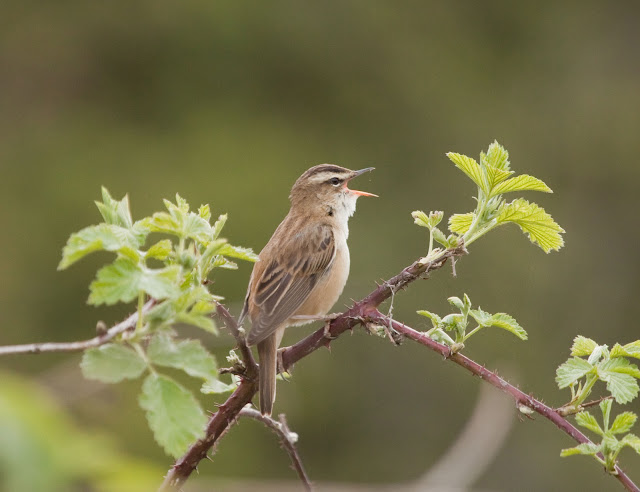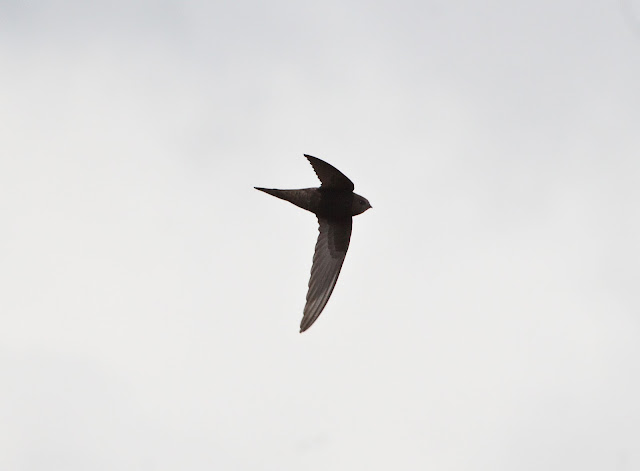Hmm....a fair possibility of catching up with rarities such
as Purple Heron and Pallid Harrier and a very good chance of meeting with a
Red-rumped Swallow? Bank holiday? Norfolk? Don’t mind if I do!
Sunday 6th May – Holkham
Sunday 6th May – Holkham
'Showing well' is not an expression usually associated with Purple Heron, but that was the news yesterday from Joe Jordan Hide. We arrived mid-afternoon. No further reports of this bird but it was still worth a look; no negative news either and slow bird news in Norfolk is hardly unusual.
Sadly the Purple Heron did not show and there were no subsequent reports, clearly it had moved on. It was interesting to learn however, that the heron had already been present several days prior to being reported.
Holkham anyway, always worth a visit. 6 Whimbrel were in a field from Lady Anne's Drive, also noted 2 reeling Gropper, 2 Spoonbill, 10 Little Egret and 4 Grey Partridge. The escaped Sacred Ibis was present. 2 Wheatear were in the dunes. 6 Marsh Harrier, single Barn and Short-eared Owl were noted.
Monday 7th May
Blakeney
A pre-breakfast amble around the gorse and shrubs of Friary Hills produced 5 Lesser Whitethroat, Common Whitethroat, Sedge, Blackcap, Chiffy and Willow Warbler. A Whimbrel and Black-tailed Godwits were in the fields.
Salthouse
Full-English now lining the stomachs it was on to Salty. Here we had 16 Whimbrel, 2 Stonechat (m&f), 7 Wheatear and Willow Warbler. Hirundines were coming in off the sea, mainly Swallows (no Red-Rumped!).
A pre-breakfast amble around the gorse and shrubs of Friary Hills produced 5 Lesser Whitethroat, Common Whitethroat, Sedge, Blackcap, Chiffy and Willow Warbler. A Whimbrel and Black-tailed Godwits were in the fields.
Salthouse
Full-English now lining the stomachs it was on to Salty. Here we had 16 Whimbrel, 2 Stonechat (m&f), 7 Wheatear and Willow Warbler. Hirundines were coming in off the sea, mainly Swallows (no Red-Rumped!).
Kelling Water Meadows
Highlights from the gate were a Whinchat, 3 Yellow Wagtail and a couple of Wheatear. Lots of Whitethroat and Blackcap along the hedgerows.
Cley Marshes NWT
Highlights from the gate were a Whinchat, 3 Yellow Wagtail and a couple of Wheatear. Lots of Whitethroat and Blackcap along the hedgerows.
Cley Marshes NWT
Some time was spent here in the hides overlooking Pat’s
Pool. A Temmincks Stint was the best bird here by far. Numbers of other waders were
low -1 Ringed Plover, 2 LRP, 1 Dunlin, 4 Common Sandpiper. Also present 2
Wheatear, a single 1st-summer Little gull and 4 White Wagtail. A
Bearded Tit was showing well on the boardwalk for one lucky photographer.
We then stopped at the Eye Field to have a look
at a Channel Wagtail which was with 3 Yellow Wags. These birds were all very
close to the car park.| Channel Wagtail |
| Channel Wagtail |
| Standard Yellow Wagtail |
The Channel Wag was a stunning little thing, subtly different than the usual Blue-headed types often seen in spring. Very nice indeed.
Holme
Holme seemed like a good place for looking for raptors etc.
Unfortuntely by the time we got there it was by no means raptor weather (ie
rather wet). It was also rather dead here. 2 Whimbrel, 1 Marsh Harrier, Whitethroat,
Redshank, Curlew and Black-tailed Godwit was about all we could muster.
Grafham Water, Cambs
We had already started the journey homewards when news came of
a Red-rumped Swallow at Grafham Water. Arrived there about 6.45pm and it was
looking challenging to say the least, as we attempted to scan distant flocks of
hirundines out in the middle of the res, in inclement conditions.
Despite continued soakings, wet optics and specs I held out
hope that the bird would perhaps return to the trees around the car park where
it had been earlier and in fact just prior to our arrival. The weather did
eventually let up and Swallows began to return to this area....it wasn’t long
before the faboulous Red-rumped Swallow reappeared. I got some very good flight views
of the bird, these were fairly brief but enough to note all the salient
features.
Alas I did not see it on the deck, as illustrated in images
by Mark Hawkes below. It lingered for a few days after my visit and would
frequently rest on the dam. A cracking little bird all the same.
| Red-rumped Swallow - many thanks to Mark Hawkes for the use of these images |

















